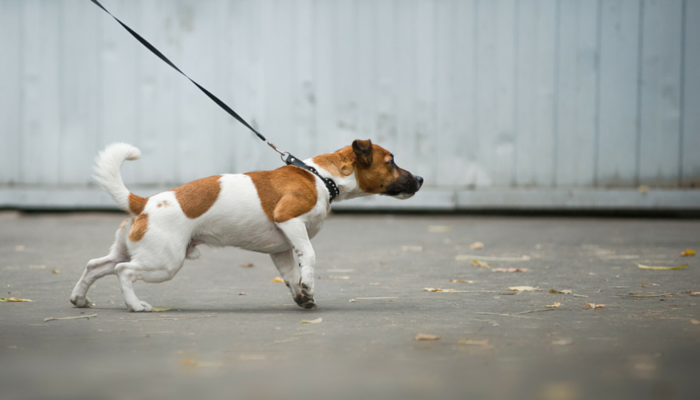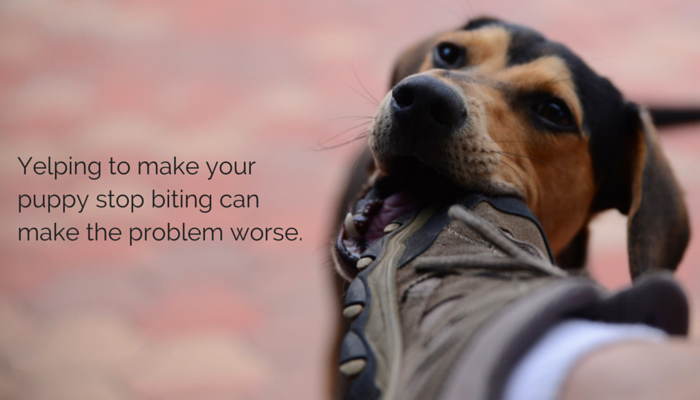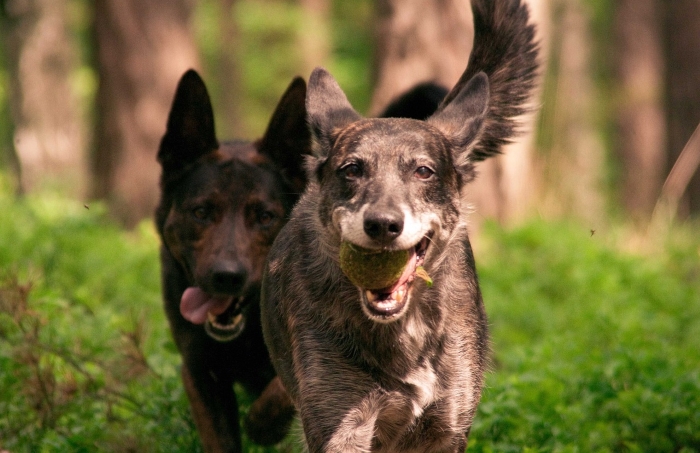10 Dog Training Tips I’m Tired of Hearing
Dog Training Has Come A Long Way
I’ve been obsessed with dogs for years, and I still remember vividly all those dogs books I owned back in the 80’s with all sorts of “solid” advice. Piles and piles of books, each one telling your how to choose and train your perfect dog. Some of the ones I remember quite well are:
- Did your dog pee on the carpet? Rub his nose in it so he knows he’s bad.
- Want to choose the nicest puppy? Alpha roll them to see which one is the most submissive. Any puppy that fights back is dominant and likely to be aggressive.
- To effectively train your dog they need to know who the pack leader is.
And this was the norm, I don’t recall hearing anything otherwise until the late 90s.
Luckily these dog training tips aren’t nearly as common anymore, they’re slowly being replaced by positive reinforcement methods. You’ll often see a lot of backlash when it comes to punishment methods, but that’s not to say that there’s still not a bunch of silly training tips and myths going around.
10 Dog Training Tips I’m Tired of Hearing
Though dog training has come a long way in the past few decades way there’s still some persistent tips & myths I’m sick of hearing. And I’m not just talking about the silliness of dominance theory either. Here’s 10 dog training tips I’m tired of hearing:
1. Be a Tree to Stop Your Dog Pulling on Leash
Do you know how many times I tried to be a tree on walks with Laika? 1329, or at least somewhere around there. And do you know how she reacted? She’d keep pulling, whining and looking at me like I was nuts.
I did this for months. Every time she’d pull I’d stop. Every step I made she’d start pulling again. It didn’t work, and from what I’ve been reading it didn’t work for your dog either.
Being a tree can work on puppies, or dogs that haven’t already learned that pulling keeps them moving forward. But if you’ve already taken your dog for a walk while he’s pulled you do yourself a favor & skip the be a tree advice. Move on to something that will work like using a front clip harness and using treats to teach your dog to follow you when walking.
The only time I think be a tree is solid advice is when you’re teaching children how to act around strange dogs.

Did you know that collars & harnesses that clip onto your dogs neck encourage more pulling? If your dog pulls on leash do yourself a favor and try out a harness that clips on the front.
2. Don’t Comfort Your Scared Dog, It’ll Just Reinforce Their Fear
Is your dog scared of storms or lightning? Better ignore them, that’ll certainly toughen them up. Or at least that’s how I imagine people who give this advice must feel. Seriously.
If you’ve ever known anyone that’s dealt with panic or anxiety you probably already know how horrible this advice is. One of the most effective ways to get over fear is to be confronted with it in a “safe” manner that includes being comforted if need be.
It’s becoming desensitized to scary situations by learning over time that nothing bad actually ends up happening during the trigger. That’s how many of us learn to confront fear – not by ignoring it.
I’m not the only one that finds this idea ridiculous. Here are two wonderful articles that discuss the topic further:
- It’s OK! to Comfort Your Dog! – Eileen and Dogs
- Please Comfort Your Dog When They Are Scared – Zoephee
By ignoring your dog during scary situations you could be making their fear worse.

We don’t ignore humans that have anxiety so why do we ignore dogs that have it? There’s nothing wrong with comforting your dog when they’re scared.
3. Assume That Your Dog is Asserting Dominance & Using Punishment
One of the biggest training myths I hear is that dogs who walk ahead of you or go through doors before you are just asserting their dominance.
Dogs love going for walks, and let’s face it, their normal pace is a lot faster than ours. It’s a natural response to pull when you’re being held back from seeing, sniffing and exploring stuff that lies ahead. If your dog is pulling on leash it’s not because they’re trying to be dominant, it’s just normal. Unless you teach your dog to walk nicely on a loose leash they’ll probably continue to pull for years.
You know why most dogs pull? Because it works, not because they’re being dominant. If you’re not stopping them they’re going to keep on pulling like it’s no big deal.
Everyone has their own preference when it comes to the positioning of their dogs on a walk. Since 95% of my walks are done in our rural town with nothing but miles of dirt roads I’m pretty relaxed. Laika’s allowed to walk ahead of me and sniff around as long as she doesn’t pull.
The only bad thing about letting your dog walk ahead is the judgments from others. There’s constant shouts of “Whose walking who?” out of car windows every 5 minutes, but just like golfers having to deal with shouts of “FOUR!!!” all day long we get used to it.
4. Yelp When Your Puppy Bites, It’ll Make Him Stop
When I yelped and said ow to Laika when she was biting me as a pup she came back 10 times worse. That noise riled her up and did nothing to stop her puppy biting frenzy.
I don’t know if the problem is whether or not our dogs believe our yelps are believable or not, but there’s no quicker way to rile up my dog than to yelp at her. She still goes into a damn frenzy when I yelp, and it’s been over 4 years since we successfully completed her bite inhibition.
But when I’m actually in pain and say ow – that stops her immediately. So maybe our dogs can tell when we’re faking, or maybe it’s the “yelp” noise that triggers excitement. Either way when us humans try yelping it tends to rile up our dogs.
Yelping might work for a few dogs, but it makes a lot of them worse.
Giving your dog a toy to redirect his behavior each time he starts to bite can work wonders, yelping might make it worse.

5. Playing Tug Will Make Your Dog Aggressive
Tug is awesome, and it surprises me that this myth is still going around. There’s nothing aggressive about tug if your dog knows how to release the toy and isn’t biting your hands. You’re playing a simple interactive game with him which is one of the best ways to spend extra time with your dog.
Letting your dog win a game of tug doesn’t show weakness; it makes your dog want to engage with your more.
Tug is such an easy way for dogs to burn a bunch of energy and use some of their natural instincts in a fun, engaging way with their owner. I’ll always defend a game of tug, and thinking of it now I can’t even tell you how many hours I’ve spent playing it with Laika.
Dogs love to tug. Humans love to play with dogs. Anytime you and your dog can do something together that you both love, it strengthens the bond that holds you together through think or thin, good times or bad, until death do your part. The four to six million dogs who end up in shelters every year in this country are a stark reminder of how much those bonds need strengthening. – Whole Dog Journal
6. Dog Behavior is “All In How They’re Raised”
The old nature vs nurture question. What makes a dog behave a certain way? While proper socialization is important as well as human interaction it’s no guarantee that you’ll always end up with a perfectly behaved dog.
Yes we may influence our dog’s behavior, but it’s important to understand that nature also plays a role. How else can we explain how former fighting dogs become loyal and well adjusted companions? Or how someone whose done everything right “by the book” ends up with a dog that suffers from fear aggression. When we do nothing but focus on a dog’s history (how they’re raised) it stunts us from moving forward.
When our dogs exhibit behavior problems it’s our responsibility to figure out how to manage it, not just blame it on what’s happened in their past.
Ask any behaviorist what’s more important — nature or nurture — and they’ll answer “both.” Some dogs can be raised by the book, socialized to everything, and still become dangerously aggressive. – No, It’s Not All How They’re Raised

The nature vs nurture debate: just like us our dogs are influenced by more than how they’re raised.
7. A Second Dog Will Help Separation Anxiety
It’s true that some dogs are lonely and could benefit from another canine friend, but a second dog is not a cure for separation anxiety.
In theory getting a second dog sounds legit; your new dog will help keep your current one company, right? Well in theory it doesn’t usually work out that way. Dogs that suffer from separation anxiety panic when their human leaves, it’s not just because they’re lonely.
When it comes to managing your dogs separation anxiety the tricky part will be identifying what events cause your dogs anxiety. If your dog starts to panic as you start to get ready for work every morning the best thing you can do is to start to desensitize them to that routine.
If your dog panics when you go to work the addition of another dog isn’t likely to help. Their anxiety will stay the same, and in some cases your anxious dog might pass those troublesome behaviors onto the new one.
Treating separation anxiety is a complex issue, if your dog suffers from it here’s a few helpful sources on treating it:
- Don’t Leave Me! (affiliate link) – Nicole Wilde
- Separation Anxiety – ASPCA
If you’re going to be adding another dog to the family make sure it’s because you want one, not because you hope it will help your current dog.

Having a second dog can be awesome, but it’s not a way to cure your current dog’s problems. Make sure a second dog is something you’re committed to before making any quick decisions.
8. Assuming That Your Dog Is Misbehaving Out of Spite
Dog’s don’t do things to make you mad on purpose, and they don’t plan things to do out of spite.
Many behavioral problems stem from boredom or anxiety. Giving your dog a structured and meaningful routine with plenty of mental & physical activity will cut down on many troublesome behaviors.
Did your dog behave well this weekend but act like a maniac on Monday? Think back about what you do each day and how your dog behaves afterward. Does he do well after a long walk & game of fetch? Add more of that into his daily routine.
Does he nap after playing a game of tug or ‘find the treats?’ Do more of that.
Find activities that keep your dog physically & mentally engaged, if you don’t they’ll come up with their own idea of fun and it’s probably not going to be something you enjoy.
While people may exercise, chew on their nails or have a drink to relieve tension, dogs tend to chew, dig, lick excessively, pace or housesoil when anxious. Because destructive behavior has many potential causes, a careful analysis of the dog’s history and environment is necessary to help identify the cause of the problem so that effective behavior modification techniques can be recommended. – Animal Humane Society

Your dog didn’t chew up your shoes to make you mad on purpose. Most dogs misbehave when they’re bored, not out of spite. Make sure you give your dog plenty of physical & mental exercise every day.
9. Assuming That Dogs Will Just “Grow Out Of It”
Unless you’re talking about that collar you bought for your Lab puppy you’re mistaken.
Dogs learn how to behave from us, the transition into a well behaved dog isn’t just nature taking its course. If you’re dog is exhibiting behaviors you don’t like it’s your job to manage the situation.
A puppy that never learns bite inhibition will grow up into a mouth dog. Your pup that jumps up on guests is going to keep doing so unless you intervene.
“Bad manners” isn’t something you have to accept, and it’s up to you to teach him how to behave properly. Sure some dogs might be easier to train than others, but all dogs need some basic manners. Your dog, your house – you decide what those basic manners will be.

Well behaved dogs didn’t just grow out of it or act well because of their breed – they’ve been trained.
10. You Can’t Train (Dog Breed Goes Here) Because They’re Stubborn
I get it. Training dogs isn’t always easy, and it’s different for each dog. Even dogs from the same little can be motivated by different rewards.
But that’s not an excuse to give up because you haven’t found what works for your dog. Some dogs don’t care about treats so you train with a tug toy in hand, others don’t like to play so you reward them by going outside.
All dogs are different, and each has their own set of rewards they’re willing to work for.
The truth is, dogs in many ways are just like people. Some dogs will pick things up very quickly and others will take more time and guidance. Often times when we as trainers see a dog having difficulty learning a task, it’s because the dog is not being communicated to in a way that the dog can understand. – Association of Professional Dog Trainers (APDT)
You see a lot of Retrievers as service or guide dogs because they’re generally predictable – but other dogs can excel in that job as well. There’s a lot of great organizations out there (like SE Michigan’s Stiggy’s Dogs) that train shelter dogs to become service dogs for veterans.
Every dog has potential, it’s up to you to find out how to motivate them to reach it.
What Training Tips Are You Tired of Hearing?
Have you tried any of these with success? What other tips are you sick of hearing?

Please share with your friends 🙂

These are all so very familiar. I love this post.
Standing still doesn’t work with my dogs, because I’m walking four dogs. Two of them combined nearly outweigh me; I don’t stand a chance against all four. So I change directions or capture their attention.
I do believe that when I comfort my dog when he’s anxious, I reinforce his anxiety, but that doesn’t mean I should ignore him. Instead, I call him to sit next to me and distract him with chatter or a game. I did this with Rodrigo on the Fourth of July one year and he became more relaxed when the fireworks started. This year, we didn’t have any issues, he slept through them.
Of course, he’s frightened of power outages (power went out at 1:30am). What can you do?
Great post!
As far as comforting a dog it’s a tough call but as you mention when you add something distracting/and or fun into the mix you’re helping to shape how the dog feels about the scary situation. Much easier to move past scary stuff that way than to have it ignored.
Very true. Every dog is different. I don’t like the idea of ignoring my dogs; but I know each of my dogs well enough to know what they need. When the power goes out, there is no distracting them, because I need to light candles go for a potty break before my boyfriend hooks up the generator, and get everyone settled down.
During this time, there is tons of cuddling and snuggling. It’s what works in that situation. I just love your blog.
Great post, these are all so true! I got tired of trying to force my Husky not to walk out in front of me, I just got real and thought “She’s a Husky for crying out loud! She was born to be in FRONT of a sled and a musher!” As long as she’s not dragging me across the county anymore, I’m ok with her being a couple of feet in front of me. I got a no pull harness (clips in front) and before long she stopped pulling my arm out of it’s socket. So what if she insists on being out in front on walks? She likes to be in front of all of us on walks. We all have a great walk & I’m good with that!
I remember when I first adopted Luna, the rescue told me not to encourage her fears. I didn’t have any experience with raising my own dog then, but it still seemed off to me. Luna has some weird fears (sewer drains, cats, etc.) probably from her time as stray. We’ve worked with her on them and while they haven’t gone away completely, she is more curious about them now and doesn’t just run away.
What a fantastic post! I’m definitely going to pin this post for future reference!
-Spencer the Goldendoodle
spencerthegoldendoodle.com
I agree with each one of your training tips as yes, “they” were wrong! I have a coonhound and I allow him to lead on most of our walks, and yes, I get the comments about who is walking who,. My response is that a dog walk is for the dog, not for me!
a scared dog should always be comforted but try to comnfort the dog not protect it (I know wht I mean )xxx
Great post! These are myths I’m really tired of, too! Another one is “A tired dog is a good dog.” That one really drives me nuts.
“Being a tree” actually works really well for Barley, but she’s a dog that prefers to be with me or at least know where I am, so when she pulls and I stop, it’s this quick reminder “oh yeah, she’s back there, what am I doing up here?” It took a long time to train that, though. It’s not just something that I stopped once on a walk and she never pulled again the rest of the walk–she’s been trained that when I stop, she stops and sits and doesn’t get up until I release her (whether that’s for pulling, or for something like stopping to talk to a neighbor or picking up poop), so usually stopping is a good way for me to refocus her, but I know that definitely doesn’t work for other dogs. We also have just as much success with changing direction or adding in a serpentine between trees. And if it makes you feel any better, even when Barley is walking calmly beside me, people still ask me “who’s walking who?”
Great post!
Such a great post! I agree with all of your points, especially regarding nature vs nurture. My (beloved) asshole Bruce was produced by a breeder who is apparently known for dogs with “issues.” I don’t think his original owners did anything wrong, except that maybe they didn’t have strong enough boundaries. They just realized they couldn’t handle him.
In our experience we’ve found that every puppy is different. What works for one doesn’t always work for others. For instance, yelping when your puppy bites made Linus go crazy just like Laika, but it worked with Stetson.
I was so happy your first training myth was “Be a tree”. I sure wish we could have tried that together so I wouldn’t have looked so ridiculous when I tried that at least a thousand times with Haley too. We could have pretended we were having a conversation at least, lol. Great article, Jen!
I’ve heard all of these! My ex told me the “rub his nose in it” thing once and we had a very stern talk about that.
Yelping and saying ow got Bentley even more excited as well! He thought that was great fun.
I keep hearing “I know you shouldn’t used pronged collars on most dogs, but my dog can’t learn”. Some deluded souls think their dog’s confusion isn’t their own fault.
These are all so great! Not so long ago, I believed quite a few of these! I still read the “tree” one quite a bit, but I gave up on that long ago….I never had the patience to keep it going for long!
Haha well you will have to put me on the list because I have used many of these “myths” with great success. Every dog is different so what works for one might not work for another. I guess that would be the tip that bugs me the most…the idea of size fits all training. I do plan to write a post on feeding into a dog’s fears in the near future.
Great points, these are myths I’m really tired of, too! Especially I don’t like to hear when people are saying that some dog breeds can’t be trained because they are stubborn.
I can honestly say I’ve heard way too many of these. People can be so ignorant sometimes! I’m glad your shedding some light on common misconceptions!
Actually, the first one (be like a tree) has been working well for me, except I step on the lead. Granted, my dog is only 6 months old and I’ve been doing it since she was 12 weeks. At first I step on the lead around the half way point of my 6′ lead (which makes it harder for her to pull me but still allows me to hold the end of the lead) until she sits, then we walk forward. If she continues to pull, I step on the lead and hold completely still, not looking at her for a full 30 seconds after she sits, then we walk forward. If she runs instead of walks or she continues to hit the end of the lead and tries to pull, I stop and pull out my cell phone and set a timer for 2 minutes. If after we start walking again she continues to run or pull, then its 5 minutes and so on. Usually she does a lot of whining so of course I make sure she hasn’t been whining for at least 30 seconds before starting the walk again. A lot of the time when she is pulling its because she has just gotten too amped (ie: saw a squirrel, leaves blew across the path, or saw another dog or human) and just needs some time of very little motion to calm back down. If she is trying to get to something specific, instead of just pulling or running instead of walking, we turn around and walk the other direction until she is walking nicely (I praise her and treat her for walking nicely) and turn around and try again. We keep this up until we can get to whatever she wants to get to while walking on a loose leash. Sometimes it takes 20-30 tries and we hardly get anywhere on the walk.
I agree with most of these! Though I will say that not all are myths. Be a tree has worked on several of my fosters and I will say that yes, dogs do things out of spite. If I leave for an hour or more, my potty trained pup with doggy door will poop in front of the door. If I leave them for longer they pee right in the middle of the room. Every. Single. Time. I think it’s their way of saying they are pissed at me lol they often do things to show their displeasure. But I agree, they don’t chew on your shoe to be spiteful lol they are usually bored.
Being a tree works. You say yourself in the same item that they have learned that pulling works. Dogs can re-learn things and you can teach them that pulling doesn’t work. Especially if instead of just stopping when they pull, you stop and then slowly back away from the direction they are pulling. So now pulling becomes counter productive. It is very effective on dogs of ALL ages the exact same way a halter or front harness works. it redirects them when they pull.
That puppy biting is equivalent to aggression!
Puppy biting occurs among nearly every breed of dog. Our furry companions don’t have hands, so they explore with their mouths. There’s absolutely no research that connects puppy biting with aggression. I call it “mouthing.” They don’t understand that those little needle teeth hurt. Check this out for more https://esacare.com/top-three-dog-training-myths-explained-by-14-renowned-experts/
All too often, these myths persist because we keep spreading them around. It’s time to take control of the message and stop poor dog training practices from proliferating.
What immediately comes to mind is, “what works for one puppy might not work for another”. Very interesting piece all the same. Bravo!